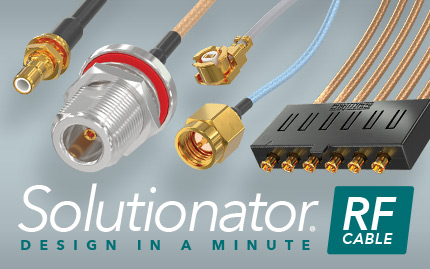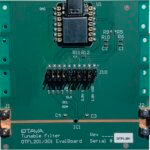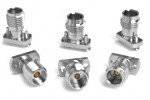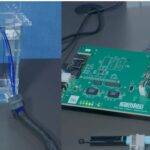It is easy for many of us to take connectivity for granted. With Bluetooth, WiFi, and the latest 5G wireless technology, we are having to use fewer connectors in everyday life. Coaxial or Radio Frequency (RF) connectors are not as common now as they were a generation ago, and yet with the demand for high-speed wireless communications growing relentlessly, the world of precision RF connectors is evolving rapidly. With demand growing for higher frequencies and greater data speeds, now is an exciting time to be looking at RF connectors, as a recent visit to the European Microwave Week conference and exhibition showed.

RF or coaxial cables and connectors are used to transmit radio frequency signals over physical infrastructure. Coaxial cable consists of a single central conductor that is surrounded by an outer conductive sheath. The inner and outer conductors are separated by an insulator called a dielectric, and the dimensions between them are closely controlled to allow for efficient transmission of an RF signal.
Joining two coaxial cables together requires a connector that will maintain the precise characteristics of the coaxial cable to preserve the integrity of the signal that is propagated along it. Coaxial or RF connectors have been a familiar sight in the world of electronics for decades. The cable that joins your television with its aerial (or more recently, your set-top box to your satellite dish) uses a coaxial connector, and for many years Ethernet networks used them for its physical infrastructure.
The 2022 European tradeshow calendar has begun in earnest, and the recent European Microwave Week has once again allowed Samtec to showcase the very latest technology in this important area. It was a great opportunity to understand the latest generation of RF connectors, a generation that is capable of far higher performance than before.

During discussions with visitors to the Samtec booth and elsewhere, there were two key trends that I found particularly fascinating. The first – unsurprisingly – was higher frequencies. Equipment capable of frequencies up to 90 GHz is becoming more common, and 110 GHz is already here. Products such as the latest 1.35 mm Precision RF connector are ideally placed to provide solutions for E-band applications, and 1.00 mm connectors are becoming available for the latest 110 GHz applications.
The other interesting subject for me to observe was the need for higher densities. RF connectors are circular, and the larger sizes can be inefficient when it comes to installing many connectors in the same space. High-density applications require connectors that are optimized for close installation, like the latest HDBNC high-density BNC connectors.
For more advanced applications, ganged or multi-way connectors are an ideal solution. The latest ganged RF solution from Samtec uses multiple SMPM miniature push-on connectors, capable of frequencies up to 65 GHz. Even more capable is the Bulls Eye® high-density array, which features Dual-Row or Quad-Row configurations that can handle frequencies of up to 70 GHz.
European Microwave Week was a great opportunity to immerse myself in this fascinating and highly specialized technology. If you want to know more, you can watch this video of my recent conversation about the Samtec precision RF program. My knowledge of this field was greatly expanded by Mike Dunne and Steve McGeary, who were able to shed light on both the driving forces behind the world of Precision RF connectors and the latest developments.

Samtec also provides an advanced cable builder tool called the Solutionator® that allows customers to create their own bespoke cable designs in minutes. If you are looking for more technical information, the dedicated Samtec Precision RF page provides a complete overview of the range including connectors, cables, and custom solutions.



Leave a Reply